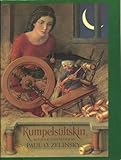Lesson 1: Plot Problems
Lesson Plan
Rumpelstiltskin | 740L

- Learning Goal
- Explain that fairy tales are focused around a problem that needs to be solved.
- Identify a problem that needs to be solved in a fairy tale.
- Duration
- Approximately 50 minutes
- Necessary Materials
- Provided: Unit Example Chart, Independent Practice Worksheet
Not Provided: Rumpelstiltskin retold by Paul O. Zelinsky, chart paper, markers, familiar fairy tales from the classroom library
-
Teacher Modeling

will explain to students that one characteristic of fairy tales is that they are focused around a problem that needs to be solved. I will add this to my Characteristics of Fairy Tales Chart (Example Chart is provided in Unit Teacher and Student Materials). A problem is a difficulty or challenge that a character in the story faces. I can identify the problem in a fairy tale by thinking about what my main character wants, and why he or she cannot get it. What is in his or her way? I will model identifying a problem in a familiar fairy tale—Cinderella. I will recall that Cinderella, the main character, wants to go to the ball. She cannot go to the ball because her evil stepmother locks her away in a cellar, and she cannot get out. Also, she cannot go to the ball because she is poor and has nothing to wear. Therefore, one of the problems in Cinderella is that she cannot go to the ball, even though she wants to. I will add Cinderella to my Characteristics of Fairy Tales Chart because it is a fairy tale with a problem that needs to be solved.
-
Think Check
Ask: "How do I identify the problem that needs to be solved in a fairy tale?" Students should answer that you identify what the main character wants and what is stopping them from getting it.
-
Guided Practice

will read the fairy tale Rumpelstiltskin retold by Paul O. Zelinsky. We will identify the problem in the fairy tale by identifying the main character, describing what the character wants, and then discussing what is in his or her way. Once we identify the problem, we will add Rumpelstiltskin to our Characteristics of Fairy Tales Chart because it is a fairy tale with a problem that needs to be solved
-
Independent Practice

will identify a familiar fairy tale and describe the problem that the main character faces. You will explain that this is a fairy tale because it is focused around a problem that needs to be solved. (Independent Practice Worksheet is provided.) Note: Teachers will need to provide the class with a variety of fairy tales for the Independent Practice.
Texts & Materials
Standards Alignment
(To see all of the ReadWorks lessons aligned to your standards, click here.)


Looking forward to implementing lesson.
Awesome!